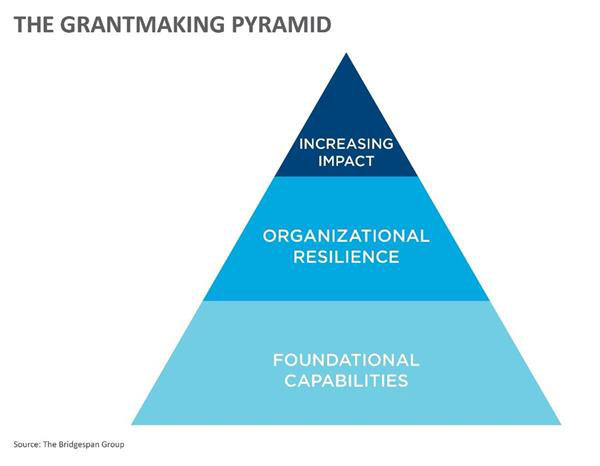
Grantmaking Pyramid Points to New Direction for Nonprofit Grants
The Grantmaking Pyramid, a graphic released by the Bridgespan Group and the Ford Foundation this week, is an attempt to help nonprofits think about grants in a new way, to focus on long-term financial strength.
It’s a simple pyramid, but two prominent organizations in the nonprofit funding space hope to use it to help organizations rethink a complicated issue: the way funders and the groups they support handle grants.
The “Grantmaking Pyramid,” released Tuesday by the Bridgespan Group and the Ford Foundation, is intended to help nonprofits focus less on winning grants to fund particular programs and more on building organizations that stand the test of time. It contains just three sections representing a “heirarchy of needs”:

The pyramid emerged from what Ford and Bridgestone learned from a survey of 300 grantees representing roughly a third of U.S. foundation spending. In an article published in the Stanford Social Innovation Review, Michael Etzel (a partner with Bridgespan) and Hilary Pennington (the Ford Foundation’s vice president for education, creativity, and free expression) noted that the survey exposed unexpected financial instability in many nonprofit organizations:
We reviewed nearly 1,500 financial statements spanning the years 2009 to 2014 from organizations with big budgets, professional staffs, and successful programs. Given the prominence of these nonprofits, many of which are household names, the results came as a surprise. More than half (53 percent) suffer from frequent or chronic budget deficits—defined as at least two of the past five years. And 40 percent have fewer than three months of reserves (specifically, liquid unrestricted net assets) in the bank to cushion financial shortfalls. In fact, 30 of the 300 organizations showed no reserves—making them technically insolvent.
The pyramid, Etzel and Pennington say, is designed to help foundations refocus on organizational capacity and financial health so they can survive in the long run—which is often the opposite of how they typically look at their finances.
“Unfortunately, organizational capabilities too often fall into a catchall, indirect-cost category typically limited to a 10-15 percent reimbursement cap,” the writers add. “This all but guarantees a shortfall. In Bridgespan’s research, median indirect costs are almost triple the typical grant allowance.”
The result is that the organizations tend not to invest enough in areas that would improve long-term performance, such as staff development, industry collaboration, or information technology.
“By focusing attention on an organization’s foundational and financial needs, the pyramid aims to prompt a discussion that leads to making investments in the right order,” Etzel said in a news release.
The Ford Foundation has made the Grantmaking Pyramid the centerpiece of its new BUILD Initiative, a $1 billion investment over five years to strengthen the resilience and effectiveness of its key grantees.
“Ford believes that its grantees must be equipped to play the long game, which means doing more to strengthen their core capabilities and financial health, not just fund programs,” Pennington said.
(iStock/Thinkstock)






Comments